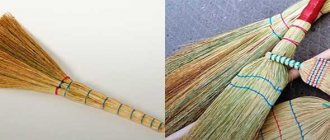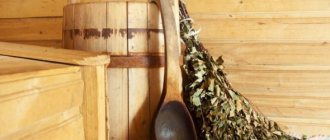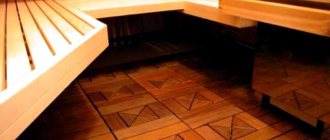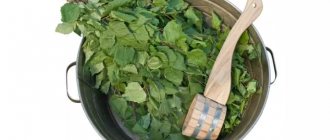Cleanliness is the key to health, and order is above all. This is exactly the phrase that was spoken by the heroes of an old, but still relevant, Soviet cartoon. Various modern means help us keep our house clean - vacuum cleaners, rags made from the latest fabrics, unique chemical compositions... But in everyone’s home there is one more item that helps keep the floor clean - this is an ordinary broom. Now it is somewhat different from its “ancestors” in the manufacturing technique and materials used. What are brooms for sweeping the floor made of?
What are brooms for sweeping the floor made of?
What should a broom be like?
Vacuum cleaners appeared in human everyday life relatively recently, with the beginning of the development of technological progress, but it was the broom that was and remains to this day the very assistant that makes it easy to keep the floor clean.
History of the floor broom
A traditional broom is a bunch of branches or twigs, used for cleaning apartments and houses, and sometimes even local areas. Although the device for sweeping streets is usually called a broom, it is still the closest relative of an ordinary broom. Previously, these bundles of twigs were also used for cleaning wardrobe items, spraying flowers or linen - the broom was simply dipped in water, and housewives fanned with it what needed to be moistened.
Broom for sweeping the floor
Typically, twigs of shrubs or stems of herbaceous plants up to 50 cm long are used to make a broom. They are secured to a short or long handle using special strands, twine, soft branches of trees and shrubs or wire.
On a note! From Old Church Slavonic, Czech and Slovenian languages, broom is translated as “bun”. This is reported in the etymological dictionary of M. Vasmer.
Sweeping the floor
Now a broom can be made from both natural and synthetic materials. Previously, their creation was carried out by people called brooms. Currently, there are large-scale industrial productions - brooms go on sale from conveyors, have become mass products, and their production has certain standards regulated by the document OST 56-31-91.
OST 56-31-91. Sorghum brooms. Technical conditions. Downloadable file (click the link to open the PDF in a new window).
OST 56-31-91
Sorghum brooms
On the territory of Russia, the broom also had cultural significance. Residents believed that a brownie lived in the “crown” of the broom, and in general this object was associated with evil spirits. However, at the same time, it was also considered a talisman for the home, a person’s wealth, and was used for fortune telling.
On a note! The broom is still important in some regions. And in the village of Semeno-Alexandrovka, Voronezh region, residents create not simple devices for cleaning the floor, but real works of art, distinguished by their special beauty. The individual rods are tied here using willow twigs.
Nowadays, a broom is considered a common household tool used for cleaning the floor. It is ideal for cleaning the base from large particles of debris that can clog the vacuum cleaner and cause it to fail. As a rule, a broom is used at one of the stages of major cleaning - first they walk across the floor with it, then they pick up a vacuum cleaner, then comes the final stage of cleaning - washing the floor with a rag.
The broom is still used today
A good broom should be durable and neat in appearance. It is not recommended to use it for a long time - it is usually thrown away approximately 10-12 months after purchase. The fact is that if it is made from natural raw materials, the branches dry out and begin to crumble over time. Thus, during cleaning, the broom itself produces more garbage than it is useful.
Where it should always be clean so that money doesn’t go away
In order for wealth to fill the house, you need to make room for it. Do regular cleaning. Remove clutter, clear space.
The kitchen and hallway are special places that should always be clean.
Cuisine is concerned with preparing and eating food. And food has always been considered a sign of prosperity. The richer and more varied the table, the richer the family. This is a place of concentration of monetary energy, which should circulate freely without coming into contact with dirt.
Money can flow with water. Make sure that in the kitchen, the place where wealth is concentrated, the taps are in working order.
The hallway is the border between our home world and the outside world. There shouldn't be any trash here.
Immediately wash the shoes you came in and remove external negativity from them.
To prevent your money from going away, immediately put your shoes on a shelf or in a closet.
Who is entitled to unemployment benefits and how much can you expect?
Remember that you need to clean the apartment during the day, making room for positive, bright flows, including money.
What are floor brooms made of?
Throughout its centuries-old history, the broom has remained virtually unchanged in appearance - only the materials from which it is made have changed. You can make this cleaning device out of almost anything. Basically, brooms are made from stems and branches of bushes and herbs, and twigs. Most often they are created from a special plant - sorghum, but we will talk about it a little lower.
To create brooms, the stems of a plant such as chiliga or wild acacia can be used. It has quite strong and flexible shoots. But such a broom is not suitable for cleaning the house because of its density and roughness.
One of the modern broom options
Brooms are also knitted from common wolfberry, a shrub popularly called “wolf berry.” By the way, this is the plant that produces the popular goji berries. But a soft broom can be made from St. John's wort, wormwood, and oregano. If you sweep the floor with such a product, the house will smell fragrant, and moths and other insects will not appear. Spiders could be expelled from a home by sweeping it with a broom made of reed stems. In villages they still use brooms made from nettles and linden branches.
The Slavs often used millet stems to create brooms. But now such products have practically sunk into oblivion - they have been replaced by softer brooms made from broom sorghum.
You can even make good money making brooms
Recommendations
Some bath attendants add a few drops of essential oil (fir, cedar, eucalyptus, citrus) to the water for steaming an oak broom. This technique allows you not only to disinfect oak branches and leaves, but also to fill the space of the steam room with bright and fresh aromas. In addition, the esters contained in the oils soften the natural hardness of oak leaves and branches.
Another original and very popular method of steaming an oak broom involves the use of herbal decoctions. Thus, a dry broom from young oak branches is often soaked or steamed in a decoction of oregano, nettle, string, chamomile, calendula, and sage. It is often used to prepare a steaming decoction and a mixture of medicinal herbs. It can be brewed both for steaming a broom and for preparing water for rinsing after a steam room.
Oak branches are considered very tough and durable, so even after steaming they may not acquire the required flexibility and softness. To check the degree of steaming of an oak broom, it is recommended to apply several light tapping blows to the area of the wrist joint (from the back). If only slight redness remains on the skin caused by the flow of blood, and the blow itself is soft and slightly tickling, this indicates that the broom is completely ready for use. If small scratches and signs of damage remain on the skin, it is worth repeating the steaming procedure again.
The following video clearly demonstrates the process of steaming an oak broom for a bath.
What is a house broom made of?
Natural raw materials have always been in price. It is environmentally friendly and does not pose a health hazard. That is why natural brooms made from broom sorghum are still used. It is also sometimes called economic.
Sorghum is an annual plant native to hot Africa. However, now it grows in India, America, Europe, Asian countries and Russia. This plant is drought-resistant, is not afraid of lack of moisture, is generally unpretentious in care, and loves warmth. Sorghum has a strong stem that is excellent for broom production.
Sorghum (lat. Sorghum)
To make brooms, only mature branches of this plant are used - a kind of panicles. In a temperate climate, they still do not have time to grow, so most of the brooms, one might say, come from the south. The highest quality products are obtained from stems that end their life and dry out on the root. Also, the best raw materials have reddish panicles and red or brown grains. Some growers even leave them on the branches to prove the quality of their product.
On a note! Not only brooms are made from sorghum. The plant is excellent for making paper, starch, and silage. In terms of nutritional properties, it is no worse than corn.
Sorghum can be used for more than just making brooms
From a business perspective, sorghum is a profitable investment. It grows well, and from 1 hectare of land you can get up to 4 thousand brooms. However, this plant is very fond of pests, which adversely affects the harvest as a whole. Sorghum can ripen to the desired state already cut, which is used by broom producers in the northern regions.
LiveInternetLiveInternet
—Categories
- KNITTING: CROCHET, SPOKES. SEWING, CRAFTS (Hobby) (1681)
- DECOR, DECOUPAGE (64)
- MAGAZINES-3 (50)
- MAGAZINES-2 (50)
- MAGAZINES (50)
- Sewing-2 (50)
- Sewing (50)
- Jackets, sweaters - No. 2 (50)
- Jackets, sweaters (50)
- Beading (22)
- MAGAZINES-4 (15)
- Jackets, sweaters No. 3 (12)
- embroidery (6)
- Sewing-3 (5)
- Internet, LiRu, programs, earnings, STUDY, BUSINESS (838)
- COOKING. Recipes for tea, drinks. Dessert. BAKERY (831)
- HEALTH: gymnastics, meditation, dancing, healthy and (634)
- EXERCISES FOR FACE AND NECK (47)
- inserts in comments, frames, diagrams, WALLPAPERS, BACKGROUND (507)
- HOLIDAY, GIFTS, EVENTS (502)
- Events of the Day - January (37)
- Events of the Day - December (37)
- Events of the Day - May (37)
- Events of the day - October (34)
- Events of the Day - April (34)
- Events of the Day - March (33)
- Events of the Day - September (33)
- Events of the Day - November (32)
- Events of the Day - February (31)
- Events of the Day - July (31)
- Events of the Day - June (30)
- Events of the Day - August (25)
- COOKING. Main course recipes (495)
- music, various songs (460)
- Valery Leontyev (422)
- TESTS, RIDDLES (421)
- Astronomy. Astrology (horoscopes). Psychic (304)
- video creation, flash, animation, photoshop (296)
- ECOLOGY, animals, birds, fish, flowers, nature (276)
- DESIGN, HOUSE, construction, MOVING, Utilities (257)
- Fashion, beauty, CHARM (250)
- WATCH MOVIES, cartoons (233)
- RELATIONSHIPS, FAMILY, PSYCHOLOGY, QUOTES (222)
- frames (216)
- EQUIPMENT, technology, SCIENCE, production (202)
- MILITARY THEME (5)
- TRAVEL, RECREATION, LANGUAGES and COUNTRIES, CITIES, VILLAGES (191)
- FUNNY AND VERY FUNNY (178)
- Miscellaneous (173)
- About the stars, interviews (150)
- Pictures, photos, photos of paintings, ART miscellaneous (148)
- POLICY. Politicians. ECONOMY (134)
- CREATION. PAINTING.Miscellaneous (124)
- INTERESTING FACTS (123)
- All about GAMES (117)
- SCHEMES (117)
- Vladimir Vysotsky (111)
- About great, famous, famous people (108)
- GARDEN WORK. PLANTS (106)
- Construction at the dacha (13)
- poems (104)
- Prayers, sacred things, PARABLES, SIGNS (102)
- LiRu's friends, photos, interviews, miscellaneous (101)
- Experienced. Memorable (92)
- Canning, PREPARATIONS (89)
- Kurgan and Kurgan people, From the KIK newspaper (77)
- My videos, song clips (74)
- CLIPART, SEPARATORS, ANIMATION (73)
- Scorpions and others (73)
- COOKING. Soups, liquid dishes (69)
- My photos, personal (69)
- I'm looking for you, mom. SEARCH (64)
- radio recordings, radio plays, online books (60)
- Chess, SPORTS (51)
- PHOTOGRAPHY (50)
- FORGOTTEN SONGS, OLD SONGS, OLD HITTS (44)
- SITE CREATION. For bloggers. CODES (41)
- Website from scratch (7)
- Legal assistance, Miscellaneous SERVICES (38)
- MUDRA (Health), MANTRAS, Relax (29)
- Books, BOOKS ONLINE. Quotes (27)
- World War II, WWII 1941-1945 (26)
- WEBINARS, CONFERENCES, TRAININGS (24)
- Alla Pugacheva (20)
- Thomas Anders (19)
- brother's poems (19)
- HOW TO OVERCOME A DISEASE. DISEASE PREVENTION (16)
- HISTORY OF RUSSIA, USSR, rulers (16)
- TV, radio channels (16)
- PANORAMAS (14)
- ENTERTAINMENT (13)
- dancing, ballet (13)
- Semyon Slepakov (12)
- lyrical songs (12)
- Sergey Bezrukov. Films, theater, etc. (11)
- Chess, SPORT-2 (10)
- CHRIS NORMAN SMOKIE (Chris Norman, “Smokey” (9)
- FRANCE. Parisian secrets (9)
- EFFECTS (7)
- GRAVITY (7)
- My frames (6)
- DICTIONARIES, REFERENCE BOOKS, rules (6)
- Ozzy Osbourne (5)
- Lyubov Uspenskaya (4)
- Alexander Rosenbaum (4)
- SPORT 2 (2)
- Burned! (2)
- Photo 2 (1)
- What's happening to us? (1)
- CERTIFICATES (1)
- If you suddenly need it))) (1)
- (0)
—Quote book
Players - Valentines 3 (click on the white circle on the heart)
Three simple frames for writing YOUR TEXT YOUR TEXT YOUR TEXT YOUR TEXT YOUR TEXT.
Happy New Year! With a new player! .
VALERY LEONTIEV “Have pity on me” (Song of the year 2019) geniavegas
The artist paints paintings that glow from within. The artist paints pictures that St.
—Applications
- Cheap flights
Favorable prices, easy search, no commission, 24 hours. Book now - pay later! - always no analogues at hand
^_^ Allows you to insert a panel with an arbitrary Html code into your profile. You can place banners, counters, etc. there - Postcards
Reborn catalog of postcards for all occasions - I am a photographer
Plugin for publishing photos in the user's diary. Minimum system requirements: Internet Explorer 6, Fire Fox 1.5, Opera 9.5, Safari 3.1.1 with JavaScript enabled. Maybe it will work - 5 friends
List of friends with description. This application allows you to place a block on your blog or profile containing entries about 5 of your friends. The content of the signature can be anything - from a declaration of love to
What are brooms for sweeping made of nowadays? Cleaning brushes
Brooms will never go away from everyday use due to the fact that there is a certain number of floor coverings that require careful handling. These are laminate, parquet, some types of tiles (for example, vinyl), etc. In no case should they be cleaned using brute force. And a broom comes in handy here.
Nowadays brooms are also made from polymers. They may have an antistatic brush and a long plastic handle. They are convenient to work with, and such brooms are also good at collecting dirt from the floor covering. Synthetic products can be used to clean any surfaces, they do not scratch anything, do not generate dust (to avoid the dusting effect when cleaning with a regular broom, you have to wet it), they allow you to reach hard-to-reach places and sweep them well.
This is what a modern broom looks like
Synthetic brooms are used for cleaning both residential premises and local areas. They are purchased by enterprises for cleaning production areas. Their main advantage is durability compared to conventional brooms and lack of fragility.
Most often, synthetic brooms are called brushes - they just look exactly like brushes, bearing little resemblance to a standard and familiar broom. They are usually made of PVC. Their cost is greatly influenced by the quality of the raw materials, the length of the handle and bristles of the brush itself, strength and manufacturer brand.
Soft synthetic floor brush
By the way, in modern artificial brooms the length of the sweeping part (broom) has become much shorter than in their predecessor - the traditional broom. But the handle has become longer and can have a variety of configurations. These brooms are lightweight and easy to clean/storage; they can be treated and disinfected with various chemical compounds.
Table. Types of brushes.
| View | Characteristic |
| Rectangular, with long handle | A universal brush, which is used for cleaning floor coverings, cleaning hard-to-reach places, and is often used to remove cobwebs from under the ceiling. Suitable for cleaning carpets, but cleans laminate and parquet well. |
| Laminate brush | Costs more than a universal brush. It has a special pile that carefully and thoroughly cleans laminated flooring or parquet. Also suitable for sweeping away dust from blinds, radiators, etc. |
| Flexible brush | Ideal for cleaning hard-to-reach places and ceilings. It has a long pile and can bend in all directions. The pile itself is also located on a curved strip. |
St. John's wort
St. John's wort has been known since ancient times for its positive healing properties on the soul and is used for depressive moods. This action is now scientifically proven. The red substance, heperecin, contained in the glands of the yellow flowers of St. John's wort, has a pronounced calming effect on the nervous system, and also strengthens the heart and eliminates obsessive-compulsive neuroses. St. John's wort is used as an anti-inflammatory, antiseptic, bactericidal, warming, antispasmodic agent, used for muscle and neuralgic pain, circulatory disorders, spasms, cramps and sciatica. St. John's wort helps with influenza, sore throat, headaches, pulmonary tuberculosis, gout, for wound healing, to eliminate various skin diseases such as psoriasis, eczema and even vetiligo, which is now considered an incurable skin lesion. To enhance the effect, first take a bath rubbed with St. John's wort oil, which, through poultices with a St. John's wort broom, is rubbed into the pores of the steamed skin. In folk medicine, it is believed that a beneficial side effect from such active use of St. John's wort can be the removal of the “veil of loneliness.”
St. John's wort oil recipe
Collect St. John's wort flowers during the summer solstice, mash them in a mortar and put them in a dark jar. Pour in hot but not boiling vegetable oil. Soak in the sun for forty days, shaking occasionally, then filter and pour into a dark glass bottle. The oil can be stored for no more than one year, after which heperecin breaks down.
A broom is a simple tool, but requires preparation
A newly purchased broom needs preparation before it can be used to clean the floor. And it is important to prepare it correctly so that it serves well and for as long as possible. There are no exact instructions for pre-processing a broom, but many use those that grandmothers and mothers shared with them.
Broom for sweeping
A new broom can be filled with boiling water, preferably with the addition of a small amount of salt (at the rate of about 1 teaspoon per 1 liter of water). Although some use only 2 tsp. for a 10-liter bucket - this does not make the procedure any worse. Leave the broom in a bucket of water until the liquid cools completely (at least 3 hours). Next, it is dried (preferably in a pressed state).
Advice! For ease of use, the broom whisk can be trimmed - cut it at a slight angle. Then it will be easier to handle hard-to-reach places and corners.
You also need to properly care for the broom so that it lasts as long as possible and does not deteriorate.
- It is not recommended to store this cleaning tool in an upright position. The best option is to place the broom on a horizontal surface after use. As a last resort, the broom is placed in a corner with the sweeping part up.
- Before using, it is better to soak the broom in a hot salt solution each time.
Three-stitched sorghum brooms
What to do with the branches after harvesting?
An attic space is a good place to store harvested branches, or a heap of hay is even better. A balcony or even a mezzanine is suitable for storing workpieces in urban conditions. In this case, the brooms will need to be pre-wrapped in paper bags.
Drying brooms
Drying brooms on the roof of the barn is also allowed. This is done in the following sequence:
- meadow hay is spread over the roof;
- birch branches are laid out on the hay with small gaps;
- a layer of hay is laid out on top of the branches;
- Every day (some experts advise increasing this period to 2-3 days) the branches turn over. This is done over the course of a month.
Most often, dried pieces are tied in pairs to a rope and stored in this position. You don’t have to knit brooms right away, but combine the branches into small sheaves. The sheaves are wrapped in hay and stored in the attic. Before going to the bathhouse, the required number of branches is pulled from the sheaf and tied into a broom.
How to knit brooms
Making a broom is not as simple as it seems at first glance. First of all, ripened sorghum is cut and sent for drying. It is usually done in a dry room where there is good air circulation. The drying time of the material is about 10 days. Next, the sorghum stems are cleared of leaves and excess seeds are removed - this is done with a special comb.
Brooms
Raw materials are sorted by size - length and thickness of the stems. On average, their consumption to create one broom is 20-35 pieces. The length should be about 85 cm. The width of the panicle is 25-40 cm.
The stems of the plant are tightly pulled together using metal and rubber rings and fastened with special pins. Twine, nylon, wire, and willow branches can also be used. Finished brooms are sent from production for sale.
Making a broom with your own hands
You can grow your own broom in your own garden plot. It is enough to buy sorghum seeds, and by autumn you will have the necessary raw materials. Let's get acquainted with the technology of creating a broom at home.
Step 1. To make a broom with your own hands, sorghum stalks are grown in your garden plot. Seeds are planted in the spring.
Sorghum on a personal plot
Step 2. In the fall, when the sorghum is ripe, its stems are cut off. It is easy to recognize the moment of pruning sorghum - the leaves of the plant begin to turn yellow, and the seeds acquire a reddish color.
Cut sorghum stems
Step 3. Large leaves from the sorghum stems are removed - a small panicle remains, which is hung upside down in a dry, ventilated room from the ceiling for proper drying. The drying period is about 10-30 days, but it is better to leave sorghum until spring.
Drying the stems
Step 4. Next, the seeds are removed from the sorghum stems - otherwise they will all end up in the room during cleaning. A regular metal bucket will help you cope with the seeds. A sorghum sprig is pushed into the bucket with a broom so that the metal handle of the bucket then rests on its stem. This way the handle is pressed against the bucket and the sorghum is between them. The stem stretches outward, and the seeds all remain in the bucket thanks to the bucket and handle.
Dried sorghum stalks
Removing seeds using a metal bucket
Step 5. It's time to form the broom. First, a smooth working surface of the broom is created. To do this, all sorghum stems are laid carefully on a flat surface. In this case, small branches should be inside the broom, large and powerful stems should be placed outside.
The stems should be laid straight
Laying the branches correctly
Step 6. To make a broom, you will need a rope about 2 m long, which is suspended on some kind of support. A wooden lever is tied to its lower part.
Next you will need a rope
A wooden lever is tied to the bottom of the rope
Step 7. Take a bunch of sorghum, select the place where the first knot will be located, and then make a loop of suspended rope around this place. The rope is fixed by pressing the foot on the lever. The rope is stretched and makes it possible to pull the broom as tightly as possible, which at this time rotates half a turn.
Forming a loop in place of the first knot
Step 8. After this, take a nylon thread and pass it through the middle of the sorghum bundle. At the location of the rope, the thread is wrapped around the future broom. The ends of the thread are tied after winding. After tying, the ends are passed through the middle of the bun again and pulled up. Excess threads are cut off.
The thread is passed through the middle of the bundle
The thread is wrapped around the broom
Step 9. Next, several more windings are made around the sorghum bunch in the same way.
Then you need to make several more such windings
Step 10. Excess stems are cut off using a sharp knife.
Trimming excess stems
Step 11. Next, the broom needs to be stitched. The following device is useful, created from two slats connected to each other by a piece of rubber. One of the strips has two holes, and the other has two bolts. The broom is placed between two slats and tightened with bolts. The panicle straightens out well.
This device will be used
The broom is placed between two slats
The panicle spreads out well
Step 12. The stitching will be done according to the principle of sewing shoes - with two threads and using an awl.
Let's get started with the firmware
Step 13. The broom is pierced with an awl and the thread laid at the bottom of the broom is picked up by it and pulled up. The top thread is pulled into the resulting loop. The lower thread is tightened.
Two threads are used
The thread laid at the bottom of the panicle is picked up by it and pulled up
The lower thread is tightened
Step 14. In the same way, the entire broom panicle is stitched in the selected place. The threads are tied at the end. You can knit a couple of rows for reliability. The ends of the thread are hidden inside the broom.
The entire broom panicle is stitched in the same way.
Step 15. Using the same principle, the place on the panicle located below the retaining slats is stitched. The broom is ready.
The broom is stitched in two places
Prices for brooms for cleaning
brooms for cleaning
Manufacturing technology
The most common material for making home brooms is a special variety of sorghum (broom).
The manufacturing technology is simple:
- In the fall, sorghum is cut. To make one broom you will need about 25-30 plants.
- The shoots are cleared of leaves and dried, hanging down with panicles. Drying lasts from 10-30 days to several months.
- Seeds are removed from dried plants.
- The shoots are collected in a bunch, placing the softer and thinner ones in the center, and the stronger and thicker ones on the outside.
- The bundle is tied tightly with twine.
- The panicle is stitched in a special way, giving it the shape of a fan.
- The working part of the broom is cut to the required length.
Do a little magic
Even if you don’t believe in miracles, you need to treat magic with caution! In fact, who knows, maybe wizards and witches hide so cleverly that they never catch the eye of ordinary people. After all, just in case, every person has some item that he tries to save: for good luck, for happiness, for “let it just be.” These are amulets and amulets, which often do not have much material significance, but are valuable as a memory of something good and happy. You can make a broom-amulet with your own hands if you want. He will become a talisman of love for his home, hard work, and the ability to see beauty. And it can actually become a talisman for your beloved home and everyone at home.
Types and purpose
According to their characteristics and design, brooms are usually divided into two main groups:
Those intended for home use are also divided into 2 subgroups:
Dust removal brooms
The dust blowers are small in size . Their working part is made of thin soft materials. They can be made from feathers, thread, or synthetic fibers that resemble fine hairs. The working attachment is attached to the handle.
For sweeping the house
Household sweeping brooms allow you to collect dust and debris from the floor. Such a tool is most often made from thin twigs and twigs. Preference is given to millet and sorghum.
A bunch of stems is tied in a special way so that a comfortable rounded handle is formed, and the lower part looks like a fan. This is necessary so that the working part covers a sufficiently large area when sweeping. Bast, ropes or polymers can also .
For the street
The outdoor broom is designed for outdoor work. To create it, twigs and branches made of willow, wolfberry or birch, which are tougher than for a house, are chosen. At the same time, they should be elastic, allowing you to sweep away leaves and other small debris.
In addition to brooms made from natural raw materials, you can use ready-made polymer samples and those made from plastic bottles. The best option for the street is to have both a broom and a broom . This will ensure better treatment of the area.
What is this for?
In witchcraft, and amulets somehow belong to the world of magic, each object has its own meaning. How to make a broom-amulet with your own hands so that it brings benefits to your home and everyone in your household? Use the right decorative details:
- coins, preferably silver, mean success in business;
- a burlap bag promises wealth;
- a bay leaf foreshadows glory;
- a head of garlic will protect you from evil spirits;
- a loaf or pretzel speaks of hospitality;
- sunflower seeds mean that there will be many children in the house;
- red pepper means a strong masculinity;
- rose hips - feminine beauty and wisdom;
- little shoes symbolize comfort in the home;
- wheat grains or beans mean prosperity and well-being;
- a figurine in the form of a house with a roof and a window will protect the entire house as a whole.
All the elements to create can be molded, although real fruits and grains are more suitable as an amulet. You can also use flowers, pet figurines, ribbons and bows, and stones for decoration. Making a talisman for your home with your own hands, finding out the meaning of each symbol, preparing the necessary elements means helping your home become more beautiful and, if you believe it, giving it protection.
Put together
When the broom is ready and the decorative elements have been selected, they need to be beautifully placed on the base broom. Experienced craftsmen and those who believe in magic do not recommend making a talisman for the home with all possible elements at once. After all, a young family needs children, and those who already have children need stability and success in business. So you should make a broom-amulet with your own hands in accordance with life circumstances. All elements must be secured evenly; their location relative to each other does not matter. The decor can be attached with glue, for example “Titanium”, or with thin wire. If the parts are molded, then the wire can be placed in the body of the figure in advance.
How to decorate?
Often decorative elements are used as talismans. What, for example, is the meaning of the broom amulet? It’s not enough to make a handmade talisman for your home and hang it on the wall; it’s also important to supplement it with meaningful elements. They can be real, store-bought items, or they can be stylizations created independently from scrap materials. The most convenient way is to sculpt them from a suitable material and paint them. Plasticine will not work, since the amulet whisk often becomes an interior decoration in the kitchen, and it can be hot there, and the plasticine will leak. The easiest way is to sculpt the necessary decor from salt dough without running around shopping for creative materials. The broom handle and its edge can be decorated with patterned braid of a suitable color.
Useful properties of sorghum
The plant has many useful qualities:
- promotes the removal of salts from the body;
- excellent antioxidant;
- helps stimulate the production of hemoglobin; the seeds of the plant are often recommended to be included in the diet in the treatment of anemia;
- has a beneficial effect on strengthening the myocardium;
- normalizes blood glucose levels;
- promotes appetite;
- takes part in the production of glucose;
- stimulates brain function;
- helps in accelerating protein synthesis;
- breaks down fats, improves metabolic processes.
Modeling mass
In order to sculpt small figures at home, there are many materials. They make both cold porcelain and clay mixture on their own. But there is the simplest material available - bioceramics. This is the name for a mixture of flour, fine table salt and water. Here is the classic recipe for such a mass:
- 200 grams of flour;
- 200 grams of salt;
- 125 grams of water.
You can improve the recipe a little by adding 100 grams of starch and another 50 grams of water. With this addition, the dough becomes more plastic, and small parts can be made from it. The mass is kneaded to a homogeneous consistency and stored in the refrigerator, wrapped in cling film. Details are molded from it as needed and left to dry in the open air. Finished items are painted with regular paints and covered with clear varnish. You can also involve children in this activity, help them sculpt figures of the appropriate size and shape, teach kids the names of certain objects, telling stories and fairy tales about them. Such a talisman will become a real guardian of the family, because spending time together will forever remain in warm memories.
Will a simple rope work?
When wondering how to make brooms for a bath, a special role should be given to attribute binding:
- First you need to tie a place near the foliage. In this way we will secure the branches of the broom so that they do not fall out when whipped. Then you need to tie the broom tightly, leaving small distances between the twine. This must be done until the very end of the broom.
You can use twine or construction twine.
The distance for the handle should not exceed 6 centimeters, otherwise the broom will not be connected enough and will quickly fall apart.
Such simple tips will help increase the service life of the attribute, and questions about how to properly knit bath brooms so that they are strong and reliable will not arise.











